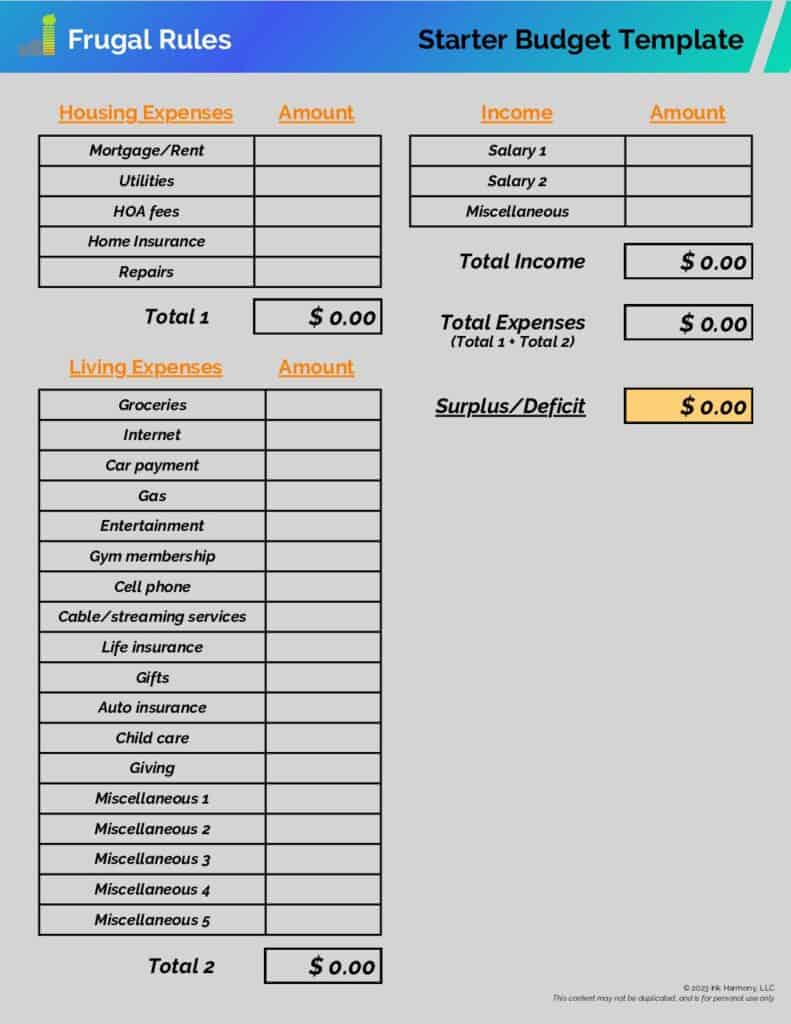I keep in mind sitting within the credit score counselor’s workplace prefer it was yesterday. I had $50,000 in debt and no concept the place my cash was going each month.
Her suggestion was like a overseas language to me, however she mentioned it was the one resolution to succeed in monetary success. She advised me to make a funds.
Years later, I do know budgeting was foundational in my monetary journey. When you’re struggling and have to develop a plan on your cash, this information may help you get began.
The best way to Make a Month-to-month Finances
Budgeting is usually considered as restrictive. Nonetheless, it lets you management your funds and freely spend cash in accordance together with your monetary targets.
Earlier than you begin, you have to to gather a couple of items of data. This contains:
- Financial institution statements
- Pay stubs
- Bank card statements
- Listing of your month-to-month payments
If potential, have at the least three months of the above items of data. It will assist you’ve got a greater concept of what you spend and earn every month.
*Deal of the day: Earn 4.65 % (11x the present nationwide common) in your money with CIT Financial institution’s Financial savings Join account. Begin with $100, and electronically deposit at the least $200 a month to earn this fee! All deposits are FDIC insured as much as the $250,000 per depositor most.
With these in hand, it’s time to create a funds.
Calculate Your Earnings
Step one to beginning a month-to-month funds is figuring out how a lot cash you earn every month. This isn’t your gross revenue. As a substitute, it’s your internet revenue.
Your revenue will embody the take-home pay out of your day job plus any cash you earn via a facet hustle.
Don’t overlook different streams of revenue. When you earn funds from sources like incapacity, Social Safety, and even alimony and youngster help, embody these as effectively.
The concept right here is to determine your whole month-to-month revenue. In case your revenue varies every month, common the quantities to get a greater concept of what you earn.
Having this info is crucial because it lets you recognize what it’s a must to work with. Moreover, in case your bills exceed your revenue, it’s essential cut back your spending.
Observe Your Spending
After calculating your after-tax revenue, you have to decide how a lot you spend every month. This contains every part you spend cash on, out of your hire to the occasional espresso you buy on the best way to work.
It’s greatest to listing all of those bills so that you just don’t overlook something. This could embody each identified and variable bills.
Mounted bills can embody the next:
- Lease/mortgage
- Utilities (gasoline and electrical)
- Web invoice
- Mobile phone invoice
- Cable or different cable options
- Debt funds
- Insurance coverage
You’ll then need to embody the variable bills that you’ve got every month, similar to:
- Groceries
- Fuel
- Charitable giving
- Leisure
- Pets
Your variable bills might look totally different, so that is meant to provide you an concept of some issues you could possibly classify as variable.
It’s greatest to common your variable spending over the course of a number of months to get an concept of what you actually spend.
You should utilize budgeting apps like Private Capital to watch your spending. Our favourite platform is Tiller. It connects to your checking account and places all your bills in an easy-to-use spreadsheet.
Alternately, you may manually write down your month-to-month bills. Nonetheless, many discover that utilizing budgeting apps is a less complicated method to handle your private funds.
No matter your alternative, monitoring your bills is crucial when you’re on a set revenue. Learn our information on how to economize on a decent funds to determine actionable methods to chop prices.
Decide What’s Left
Now that you’ve got your month-to-month revenue and bills, you need to subtract the 2 to determine the place you stand. The objective is to have cash left over.
Having more money on the finish of every month allows you to lower your expenses in your emergency fund, develop your retirement fund, or attain different targets.
Nonetheless, when you’re falling quick, it’s time to revisit your spending habits and spend much less every month. This may be an awesome feeling, but it surely’s doable.
As a substitute of wanting on the gulf as a complete, determine easy modifications you can also make to shortly cut back the shortfall. It will construct the boldness it’s essential decrease your month-to-month payments throughout the board.
Learn our information on how to economize each month to determine potential methods to spend much less.
You should utilize our printable funds worksheet under to start out a primary plan. Enter your month-to-month revenue within the “Wage 1” subject.

When you’ve got a companion, put their wage info within the “Wage 2” subject. Any revenue you earn on the facet ought to go within the “Miscellaneous” part.
Then, fill out the expense fields with the prices that apply to you. After you provide all the info, you need to see a surplus or deficit line on the underside proper of the spreadsheet.
Obtain Our Free Starter Finances Template Now
What to Do With the Remaining Cash
Spending lower than you make is a terrific place to be in. It supplies the power to succeed in financial savings targets and pursue monetary freedom.
Managing what you’ve got remaining is simply as private as a funds. You need to use these funds to work in direction of attaining what issues most to you.
Examples embody:
- Saving for a home down cost
- Debt reimbursement
- Saving for a household
- Investing for retirement
- Saving for a big expense
Residing by a funds is a superb useful resource to make use of that can assist you obtain these targets. Earlier than you’re employed in direction of them, be sure to’re rising your emergency financial savings to deal with any surprising bills.
It’s greatest to automate your saving to work in direction of your targets. Most banks mean you can do that free of charge, and it’s easy to arrange. It additionally ensures you received’t neglect to save lots of.
*Associated: Learn our information on find out how to funds for shopping for a home whenever you’re available in the market on your first residence.
CIT Financial institution is our favourite on-line financial institution to make use of for financial savings accounts. They pay tremendous aggressive charges and have the identical FDIC insurance coverage you get at your native financial institution.
Learn our CIT Financial institution overview to study extra. Beginning to save early is crucial.
Learn our information on a penny doubled for 30 days to study the significance of starting early and the facility of compound curiosity.
Rinse and Repeat
Residing on a funds isn’t a set-it-and-forget-it state of affairs. Your spending patterns might change, otherwise you would possibly earn extra revenue you weren’t planning on in your preliminary funds.
It’s greatest to reassess your funds at the least semi-annually. When you’re working to construct your first month-to-month funds, you need to analyze it weekly. When you’re snug, you may revisit it month-to-month or quarterly.
This allows you to optimize your spending and ensures that you just’re giving each greenback a function. Don’t let this overwhelm you. It’s not a troublesome course of.
Utilizing a budgeting app is a simple method to streamline it and requires solely minutes of your time every month.
Moreover, this helps you keep away from merely making ends meet. Learn our information on find out how to cease residing paycheck to paycheck to determine methods to create surplus in your funds.
Select a Budgeting Methodology
It may be difficult to decide on between the obtainable funds methods and strategies. There isn’t an strategy that’s superior to others, however there may be one that could be a higher match for you.
What issues most is that you just begin and handle your cash in a approach that helps you attain your targets. Listed here are three common budgeting types.
Zero-Primarily based Budgeting
Zero-based budgeting is an efficient alternative if you wish to give each greenback a function. You allocate all your cash to bills, month-to-month financial savings, repaying debt, and different targets.
When you don’t at present watch your spending, this can be a good strategy to make use of. Consider it as an ongoing film of all of your spending.
Nonetheless, a zero-based funds can take fairly a little bit of time to handle. Moreover, in case you have recurring bills that often change, it will not be your best option.
You Want A Finances (YNAB) is a improbable budgeting app to make use of when you select this strategy.
Money Envelope Budgeting
Money envelope budgeting is a conventional technique of managing your money. My spouse and I used this technique once we have been first married, and it helped us attain varied targets.
With this technique, you pull out money each time you’re paid and assign it to a spending class. You may learn our article on funds percentages by class to grasp what these ought to appear to be.
Utilizing this technique helps you keep away from overspending. It additionally helps you keep away from overdraft charges.
Nonetheless, you could not need to carry money round or discover it too burdensome to handle.
Qube is a useful app to make use of when you select this strategy.
50/30/20 Finances
A percentage-based funds is an efficient alternative if you wish to simplify issues and solely cope with a couple of spending classes. The 50/30/20 technique is the most well-liked alternative.
Right here’s the way it works:
- You allocate 50 % of your revenue to wants like housing and meals
- You allocate 30 % to needs like journey and leisure
- The remaining 20 % goes in direction of financial savings and debt reimbursement
The fantastic thing about this strategy is that it lets you’ve got a framework to work with that’s versatile. It additionally places a loyal give attention to saving and repaying debt.
Learn our information on find out how to repay debt shortly if it’s essential remove indebtedness.
Nonetheless, it might encourage overspending when you’re a high-earner. Moreover, low-income folks might have to spend over 50 % of their revenue on their wants.
The best way to Keep on with a Finances
You’ll discover one key factor as you discover ways to funds cash. It’s possible you’ll discover that it may be troublesome to stay inside your means at occasions.
That’s okay and is one thing many individuals expertise. A funds ought to offer you freedom and never numerous hours stressing over your funds.
One of the simplest ways to stay to a funds is to often verify it and cut back bills the place potential. As you’re beginning out, have a look at your funds weekly. You’ll quickly study you may transfer that to monitoring it month-to-month.
When you discover that you just’re not getting worth out of an expense, search for methods to scale back the fee. Then you may reallocate the financial savings to a special objective, expense, or your emergency fund.
The objective is to spend your cash according to your values and mean you can stay the life you need. Don’t hesitate to provide your self small rewards for reaching necessary targets.
Backside Line
Residing on a funds is a crucial step to take to handle your funds properly. It lets you see the place your cash goes and ensures that it’s according to your targets.
Finished sensibly, a funds offers you the liberty to stay as you need. Simply make sure you personalize it to perform what you want.
How usually do you verify in in your funds?
I’m John Schmoll, a former stockbroker, MBA-grad, revealed finance author, and founding father of Frugal Guidelines.
As a veteran of the monetary companies business, I’ve labored as a mutual fund administrator, banker, and stockbroker and was Collection 7 and 63-licensed, however I left all that behind in 2012 to assist folks discover ways to handle their cash.
My objective is that can assist you acquire the information it’s essential turn into financially unbiased with personally-tested monetary instruments and money-saving options.
Associated


